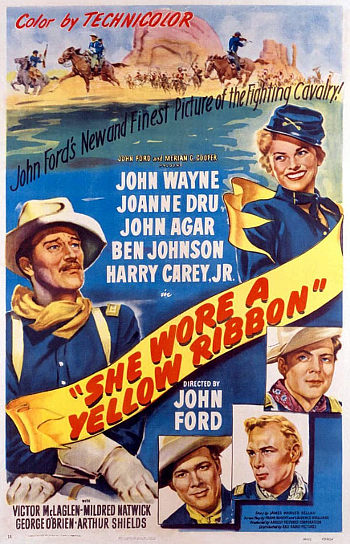 John Wayne is Capt. Nathan Brittles, a cavalry commander facing retirement just after the Battle of the Little Bighorn, as Cheyenne dog soldiers begin raiding in his region.
John Wayne is Capt. Nathan Brittles, a cavalry commander facing retirement just after the Battle of the Little Bighorn, as Cheyenne dog soldiers begin raiding in his region.
He’s sent on a final detail, to round up patrols, drive the renegades north if possible and deliver two women for a stagecoach trip east and out of danger.
Of course, he protests the latter. He doesn’t want his final patrol saddled with pretty Olivia Dandridge (Joanne Dru) and Abby Allshard, the wife of his commanding officer.
But they set off nevertheless. And while the women remain out of harm’s way, little else goes right.
Brittles and his men aren’t at the relief station to assist a small patrol fleeing hostiles. The commander of that patrol is seriously wounded.
Brittles fails to keep scoundrels from delivering a load of guns to the Indians. And he arrives at the relay station only after it’s already been attacked at the cost of several lives.
So he’s forced to return to Fort Starke with the two women, declaring his final detail a failure.
Worse yet in his mind, he’s left part of the troop behind to guard his retreat to the fort. And his plea to rejoin those troopers is denied.
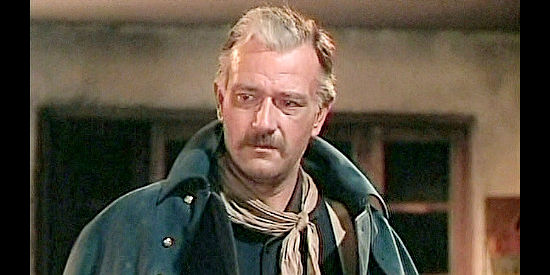
John Wayne as Capt. Nathan Brittles, asking for a chance to rescue the rear guard he left behind in She Wore a Yellow Ribbon (1949)
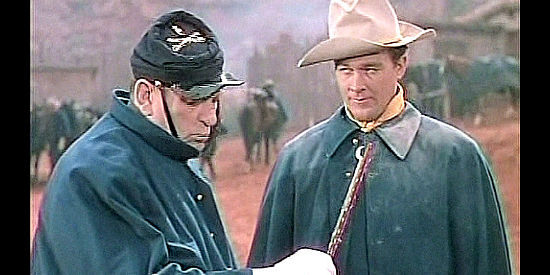
Victor McLaglen as Sgt. Quincannon and Ben Johnson as Sgt. Tyree, trying to identify an Indian arrow in She Wore a Yellow Ribbon (1949)
Beautifully filmed in Monument Valley, this marked the second of Director John Ford’s cavalry triology, following “Fort Apache” (1948) and coming before “Rio Grande” (1950).
And Wayne turns in a sterling performance as a man who’s spent four decades in a uniform, isn’t sure what comes next, but knows he isn’t about to settle into a rocking chair back East.
He gets help from a subplot that has Joanne Dru, looking oh so fine in a cavalry kepi and blouse, toying with the hearts of two young lieutenants.
And he gets help from a trio of Ford regulars, John Agar and Harry Carey Jr. as those lieutenants and Ben Johnson as Sgt. Tyree, a former Confederate who might know more about Indians than anyone else in the command.
Victor McLaglen plays Sgt. Quincannon, a longtime friend of the captain’s who’s also about to retire. His role as comic relief is one of the film’s weaker points.
Still, Ford presents another compelling Western, even though most of the Indian fighting takes place off screen.
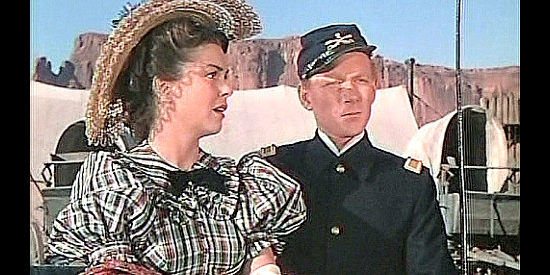
Joann Dru as Olivia Dandridge, preparing to go picnicking with Lt. Ross Pennell (Harry Carey Jr.) in She Wore a Yellow Ribbon (1949)
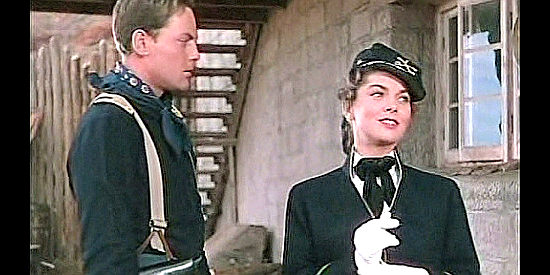
John Agar as Lt. Flint Cohill noticing the yellow ribbon Olivia Dandridge (Joanne Dru) is wearing in She Wore a Yellow Ribbon (1949)
Directed by:
John Ford
Cast:
John Wayne … Capt. Nathan Cutting Brittles
Joanne Dru … Olivia Dandridge
John Agar … Lt. Flint Cohill
Ben Johnson … Sgt. Tyree
Harry Carey Jr. … 2nd Lt. Ross Pennell
Victor McLaglen … Sgt. Quincannon
Mildred Natwick … Abby Allshard
George O’Brien … Maj. Mac Allshard
Arthur Shields … Dr. O’Laughlin
Michael Dugan … Sgt. Hockbauer
Chief John Big Tree … Chief Pony That Walks
Fred Graham … Sgt. Hench
George Sky Eagle … Chief Sky Eagle
Tom Tyler … Cpl. Mike Quayne
Noble Johnson … Chief Red Shirt
Runtime: 104 min.
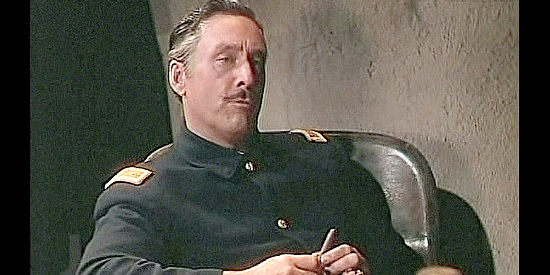
George O’Brien as Maj. Mac Allshard, weighing Capt. Brittles’ request to return to the field in She Wore a Yellow Ribbon (1949)
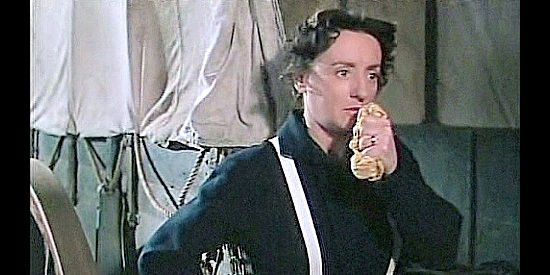
Mildred Natwick as Abby Allshard, recovering after helping treat a badly wounded cavalryman in She Wore a Yellow Ribbon (1949)
Memorable lines:
Capt. Brittles, as the fort learns of an attack on a stagecoach: “What in blazes would the Cheyenne be doing this far south?”
Sgt. Tyree: “That ain’t my department, sir.”
Capt. Brittles to one of his junior commanders: “Never apologize, mister. It’s a sign of weakness.”
Olivia Dandridge: “I’m sorry I made such a fool of myself at the gate this morning.”
Capt. Brittles: “Made a fool out of a couple of young lieutenants. That’s never against army regulations.”
Capt. Brittles, asking to return to the men he left behind: “Look, 40 years a good soldier. I can’t leave Cohill facing those devils.”
Capt. Brittles: “Old soldiers, Ms. Dandridge. Someday, you’ll learn how they hate to give up.”
Capt. Brittle, as he walks into a Cheyenne camp: “Were you ever scared, Sgt. Tyree?”
Sgt. Tyree: “Yes, sir. Up to and including now.”
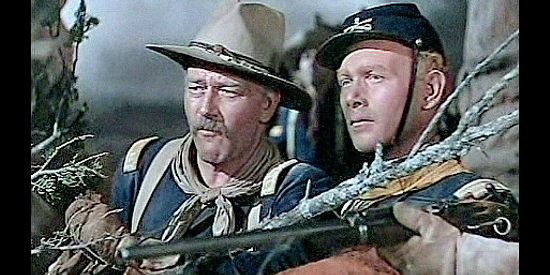
John Wayne as Capt. Brittles and Harry Carey Jr. as Lt. Ross Pennell, watching Indians torture a gunrunner in She Wore a Yellow Ribbon (1949)
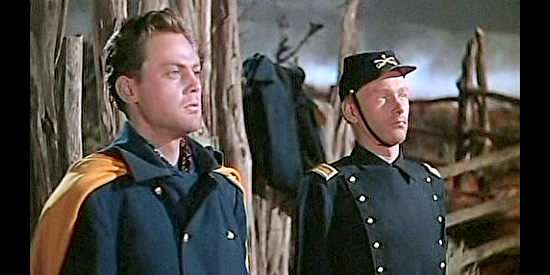
John Agar as Lt. Flint Cohill and Harry Carey Jr. as Lt. Ross Pennell, caught arguing over Olivia in She Wore a Yellow Ribbon (1949)
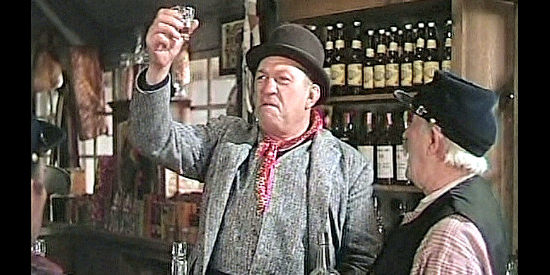
Victor McLaglen as Sgt. Quincannon makes a toast to the retiring captain in She Wore a Yellow Ribbon (1949)
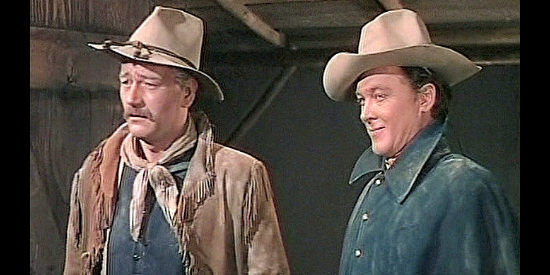
John Wayne as Capt. Nathan Brittles and Ben Johnson as Sgt. Tyree return to Fort Starke in She Wore a Yellow Ribbon (1949)

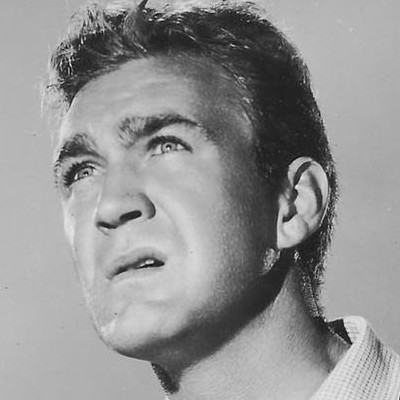
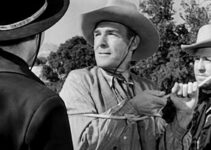
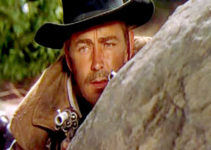
If you’re in full patriotic dudgeon this Memorial Day weekend, you could pick many worse movies to watch than She Wore a Yellow Ribbon. Released in 1949, just four years after the conclusion of WW II, this is a Western filled with the exuberance of victory, and although set somewhere on the Great Plains (though shot in Monument Valley), it almost feels like a WW II film. SWAYR’s title song is certainly a variation of “The Army Goes Rolling Along.”
At any rate, It’s a cavalry picture set in the immediate aftermath of General Custer’s defeat in 1876. And it is soon-to-be-retired Captain Nathan Brittles’ job to contain an Indian breakout and prevent the eruption of a new frontier war. In a very real sense, it’s what we might now call a “peace-keeping mission,” albeit without any blue hats.
This film won an Oscar for Best Color Cinematography and it’s easy to see why. The various cavalry charges, stampedes and skirmishes, shot at wide angles against the majestic Monument Valley vistas, are thrilling. And the colors of the skies, which are sometimes so garish as to be expressionistic, are otherworldly. As a plainsman myself, I’ve seen many a dramatic skyscape, but nothing quite like we see in SWAYR.
The acting is anywhere from good to excellent. Duke falls in the former rubric. There’s a bit of overacting, particularly when he bawls out orders to his troops, but it’s barely worth mentioning. (Is it just me or did John Wayne’s acting improve over time? I think he was a better actor in his later films than the earlier ones.) Victor McLaglen hams it up big time as Sergeant Quincannon, Brittles’ faithful Irish pal. And then there’s the marvelous Ben Johnson. The bigger his role, the better the film, and he has a very substatial role in SWAYR. In this picture he plays an ex-Confederate soldier who happens to be a past master of Indian lore and tactics. He impresses Brittles and despite his low rank (sergeant), becomes Brittles’ most trusted advisor.
As an aside, it is interesting that in the vast majority of Westerns, particuarly those made before ca. 1967, Confederates and the Confederacy are treated with great respect. No toppling statues and renaming military bases as a means of retroactive punishment here. Verily, the past is a different world.
All in all, this is a rip-snorting and exhilirating Western from an age when America was actually proud of itself rather than ashamed. As noted above, choice fare for a Memorial Day weekend.